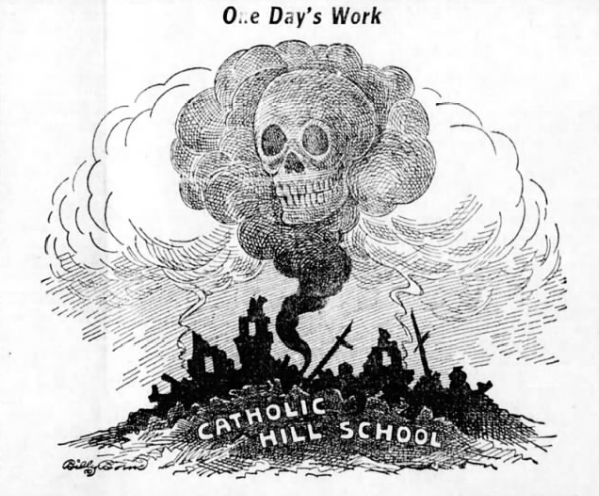Catholic Hill School — Asheville’s first school building constructed to serve the African-American community — was built in 1892. The three-story brick building held classes for students in the first through ninth grades. On Friday, Nov. 16, 1917, the school’s furnace malfunctioned. Fire consumed the building, and seven students perished in the flames.
In 1923, Stephens-Lee High School opened on the former location of Catholic Hill. It would gain recognition across the state as a leader in education, music and athletics. In a 1975 Asheville Citizen-Times article by Henry Robinson (as cited in Nan Chase’s book, Asheville: A History), the writer notes:
Stephens-Lee assumed a number of roles in those days, one of which was the black community’s center on art and culture.
Throughout the school year, the school presented band concerts, art exhibits, modern dance recitals, dramas and chorus performances. Usually these events were attended by a capacity crowd.
In 1965, South French Broad High School replaced Stephens-Lee. When Asheville integrated its schools in 1968, South French Broad was pressed into service as an integrated junior high school.
The following excerpt comes from a 1917 Saturday Morning edition of The Asheville Citizen. The article, “Death Toll At Catholic Hill School May Be Eight Children,” reports on the fire and its tragic outcome.
Thanks as always to the Pack Memorial Library’s Special Collections, North Carolina Room for its assistance.
On Saturday, Nov. 17, 1917 the The Asheville Citizen reports:
In what has been the most disastrous fire from the viewpoint of loss of life in the history of Asheville, the Catholic Hill school, an institution given over to the education of colored children, was totally destroyed yesterday, and from five to eight of the children were burned to death. The fire, which started in or close to the furnace room of the school, had gotten well under way before it was discovered, and by the time the various classes had been warned, the smoke was belching through the hallways and the flames making headway up the main avenue of escape, the central stairwell, which serves for all three floors of the building, and faces the front doorway. Splendid discipline was responsible for the saving of the majority of the 300 children in the school at the time, the teachers cooly guiding their children out, and only one serious case of panic being reported. This occurred when the children in the 3B grade, located on the third floor, became frantic over the suffocating clouds of smoke that were sweeping into their room, and in spite of the efforts of the room teacher to keep order, swept her aside and bolted for the halls and the fire escape. Five of the identified dead and missing were from this class. The charred bodies of the five little ones were carried to Murrough’s Undertaking establishment before darkness ended the searching among the smouldering ruins last night; and at a late hour three of these children had been identified by grief-stricken parents. Besides the five bodies already recovered, it is expected that three others will be found among the soaking ashes and charred timbers that are all that is left of the Catholic Hill school house.
Next week we will continue with the excerpts from the 1917 report.






Before you comment
The comments section is here to provide a platform for civil dialogue on the issues we face together as a local community. Xpress is committed to offering this platform for all voices, but when the tone of the discussion gets nasty or strays off topic, we believe many people choose not to participate. Xpress editors are determined to moderate comments to ensure a constructive interchange is maintained. All comments judged not to be in keeping with the spirit of civil discourse will be removed and repeat violators will be banned. See here for our terms of service. Thank you for being part of this effort to promote respectful discussion.